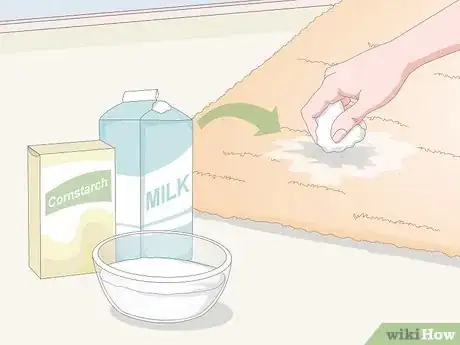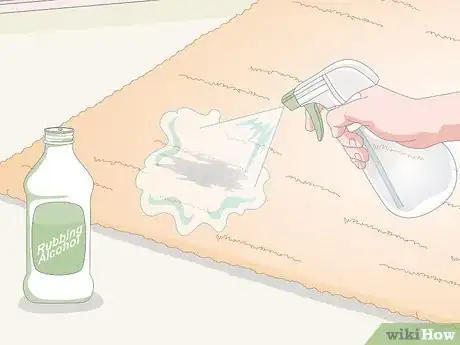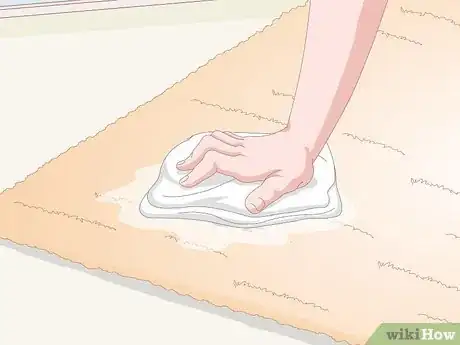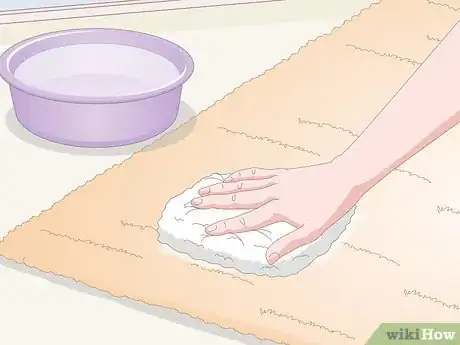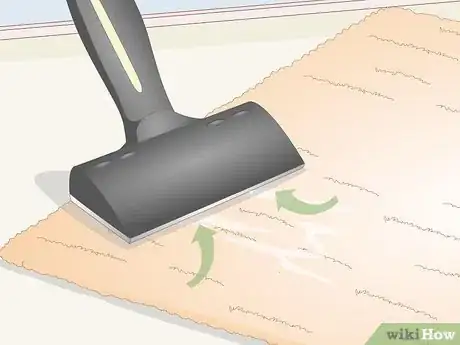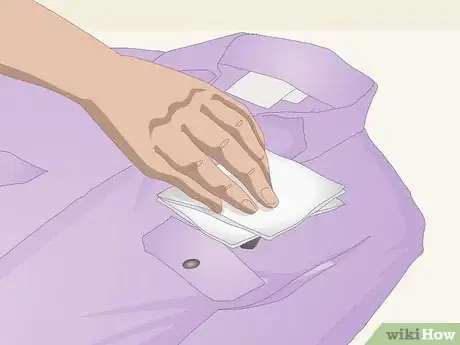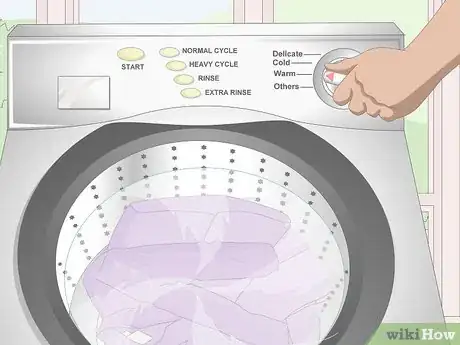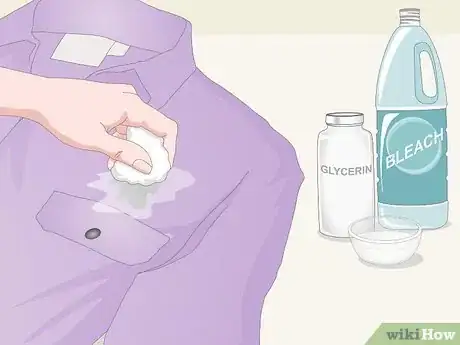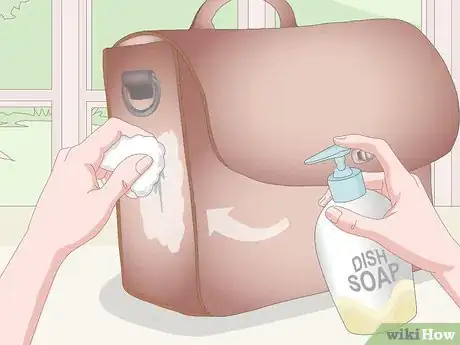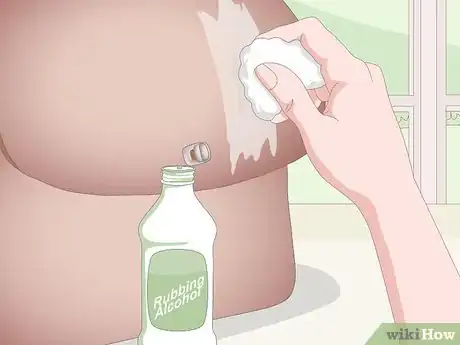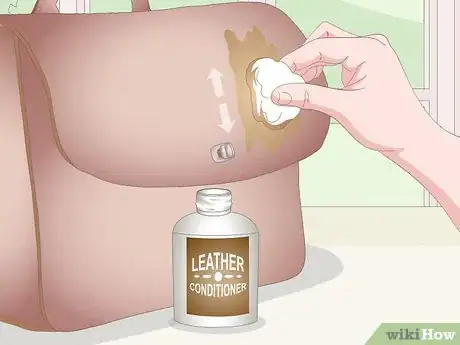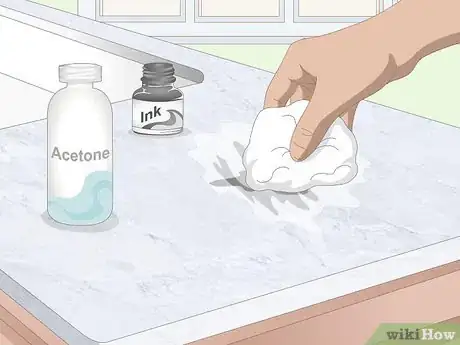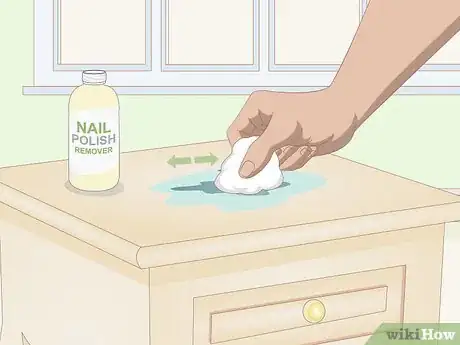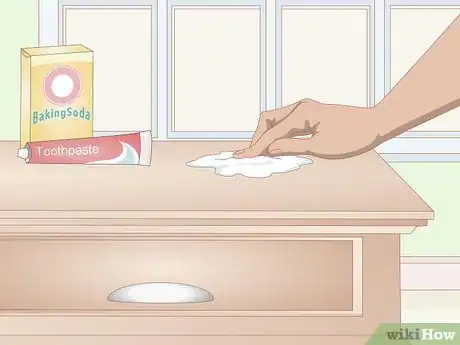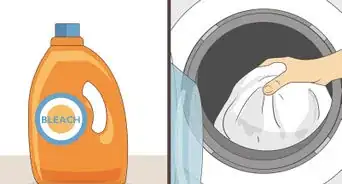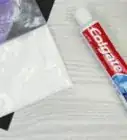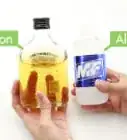This article was co-authored by Michelle Driscoll, MPH. Michelle Driscoll is the Owner of Mulberry Maids based in northern Colorado. Driscoll received her Masters in Public Health from the Colorado School of Public Health in 2016.
There are 10 references cited in this article, which can be found at the bottom of the page.
This article has been viewed 8,945 times.
Ink stains are really annoying, but there are some easy ways to remove them. If the stain is on carpet or clothing, use rubbing alcohol to remove the ink. If the stain is on finished leather, use dish soap and a leather ink stick to remove the bulk of the stain and then remove any remnants with rubbing alcohol. If the stain is on a hard surface, use the relevant method to remove the ink. Treat ink stains when they are fresh whenever possible, and always test your removal method on an inconspicuous area first.
Steps
Removing the Stain from Carpet
-
1Make a paste out of cornstarch and milk and apply it to the stain. Use 2 parts cornstarch to 1 part milk. Spread the paste over the stain and let it dry for at least a few hours. Then, vacuum up the powder once it has dried.
- Use dish soap and water to remove any remaining cornstarch paste residue.
-
2Spray the stain with rubbing alcohol. Dampen the entire area with rubbing alcohol. This helps to bring the stain to the surface and makes it easier to remove. If you don’t have any rubbing alcohol, use lacquer hair spray instead.[1]
- Purchase rubbing alcohol spray from a hardware store. If you can’t find a spray, simply dampen a cloth with the rubbing alcohol and spread it over the stain.
- Water and dish soap also work well for cleaning up water-based ink stains.[2]
Advertisement -
3Blot the ink stain with an old, clean cloth. Place a cloth over the ink stain and gently press down on it. This causes the ink to transfer from the carpet onto the cloth. Use an old cloth to avoid staining a good one.[3]
- Continue to spray the stain and blot it until the stain is gone.
- Never rub the stain as this will make it bigger. Press the towel into the stain to blot it up.
-
4Use a towel and warm water to remove the alcohol from the carpet. Dunk a towel in warm water and then squeeze out any excess drips. Gently dab the wet towel on the carpet to remove the rubbing alcohol residue.[4]
- Use a clean, old towel for this task.
- Rubbing alcohol won’t discolour your carpet. Removing the alcohol simply helps to take away the smell.
-
5Vacuum up any excess water. This helps to prevent water marks from forming on your carpet. Wet-vacuum the entire wet area to help dry the water and then leave any remaining water residue to air-dry.[5]
- Keep children and pets away from the stain while it dries, as walking on the area can push the water further into the carpet.
- Always use a wet-vacuum to avoid electrocution.
Cleaning Ink Stains on Clothes
-
1Use a paper towel to blot as much of the ink as you can. If the stain is wet, try to remove as much of it as possible with a paper towel. Place the paper towel over the stain and then gently press down. If the paper towel becomes saturated, use more paper towels to absorb the remaining ink.[6]
- If the ink stain is old, skip this step.
- If you don’t have any paper towels, use tissues or toilet tissue instead.
-
2Dab the stain with rubbing alcohol. Wet a cotton pad with rubbing alcohol and then gently press it onto the ink stain. This helps to draw the ink out of the fabric and onto the cotton pad.[7]
- Continue to dab the stain with rubbing alcohol until it disappears.
- A clear, alcohol-based hand sanitizer will also work as a substitute for rubbing alcohol.[8]
-
3Wash the garment on a hot wash, if the fabric can handle it. Check the label of your garment to find the washing instructions. If permitted, place the garment in the wash on the hottest setting.[9]
- If the item requires handwashing, wash it in hot water by hand.
- If your garment is made from delicate fabric, such as silk or lace, it will likely require a cold or warm wash.
-
4Apply a glycerin and bleach solution to the area if the stain persists. Mix 1 tablespoon (15 mL) of glycerin, 1 tablespoon (15 mL) of oxygenated bleach, and 1 teaspoon (4.9 mL) of liquid dish detergent in a bowl. Dap the solution onto both sides of the stain and leave it to soak in for 5 minutes. After this, wash the item to remove the solution.[10]
- Purchase glycerin from a pharmacy or supermarket.
-
5Soak the item in hydrogen peroxide, bleach or milk for tough stains. If the stain will not come off from the item, then you may need to soak it overnight. Use hydrogen peroxide for colored clothing, bleach for white clothing, or milk for delicates. Place the item in a bowl and pour enough of the solution over the item to cover it. Let it sit for a few hours or overnight. Then, rinse the item and wash it as you normally would.
- Make sure to wear gloves when retrieving the item if you soak it in hydrogen peroxide or bleach.
Getting Rid of Ink Stains on Leather
-
1Take naked leather to a professional to be cleaned. Naked leather is extremely delicate and is easily marked, especially by liquid. If the ink stain is on naked leather, take it to a professional dry cleaner or leather specialist to avoid further damage occurring.[11]
- Naked leather is smooth and will absorb drops of water quickly. Finished leather tends to have a slightly patterned finish and doesn’t absorb water quickly.
-
2Blot the stain with dish soap if your stain is on finished leather. Place a few drops of dish soap onto a white cloth and gently rub the stain. Avoid scrubbing the stain, as this can cause it to bleed further into the leather.[12]
- Use a white cloth to avoid the colour from the cloth transferring onto the leather.
-
3Rub the stain with a leather ink stick, if required. If soap didn’t get the stain out, try using a leather ink stick. Purchase a leather ink stick online or from a leather store and coat the entire stain with the product. Use the leather ink stick in the same way that you would use a glue stick.[13]
- Always check the leather’s care instructions before applying products to the leather.
- Avoid using solvent-based products on leather, as these tend to be quite drying. Look for a leather ink stick that is marketed as “solvent-free.”
-
4Clean any remnants of the stain with rubbing alcohol. Dampen a cotton pad with rubbing alcohol and rub it back and forth over the stained area. This will help to remove the rest of the ink from the leather.[14]
- Continue to rub the area until the stain is gone.
- If you don’t have any rubbing alcohol, use lacquer hair spray, as this contains alcohol.
-
5Rub leather conditioner over the area to moisturise it. Dampen a clean cloth with leather conditioner and rub it over the stained area. This helps to restore the moisture in the leather and prevents cracks from occurring.[15]
- Purchase leather conditioner from a leather store or homeware store.
Removing Ink from Hard Surfaces
-
1Use acetone or rubbing alcohol to remove ink from laminate or plastic. If you accidentally drop ink on your laminate countertop or on plastic, these chemicals will help to dissolve it. Dampen a clean cloth with acetone or rubbing alcohol and gently rub it over the stain to help lift the ink up to the surface.[16]
- If you don’t have any acetone, use a nail polish remover that contains acetone.
- If you have sensitive skin, wear cleaning gloves to protect your skin.
-
2Rub the stain with nail polish remover if it is on wood. Dampen a cloth with nail polish remover that contains acetone and dab it onto the stained area. Rub the area as quickly as you can, as the acetone will quickly strip varnish and paint from the wood.[17]
- This works best on natural wood, as the nail polish remover will likely remove the polyurethane finish of the wood. In order to restore the look of the wood, you will need to sand it and reapply the polyurethane to the area.
-
3Combine baking soda and toothpaste and rub it on the stain. Mix together 1 tablespoon (5 g) of baking soda and 1 tablespoon (15 mL) of toothpaste in a small bowl until they form a thick paste. Then, apply the paste to the stain. Let it sit until it dries and then wipe away the excess. Wipe the area with a clean, damp cloth to get any remaining paste off the surface.
- Repeat as many times as needed to remove the stain.
-
4Use ammonia, water, and scouring powder to remove ink stains from cement. Mix 1 cup (240 mL) of water and 1 tablespoon (15 mL) of ammonia in a bowl. Cover the stained area with water and then saturate a piece of cotton batting with the ammonia solution. Place the batting over the stain. Once the batting dries, sprinkle scouring powder over the stain and scrub the area with a stiff brush. Continue to scrub the area until the stain is gone.
- Rinse the area with water to remove the scouring powder and any remnants of ammonia.
- Purchase cotton batting from a fabric shop.
- This method only works on concrete that hasn’t been polished.
Things You’ll Need
Removing the Stain from Carpet
- Cornstarch
- Milk
- Rubbing alcohol
- Towel
- Clean cloth
- Vacuum
Cleaning Ink Stains on Clothes
- Rubbing alcohol
- Paper towels
- Washing machine
- 1 tablespoon (15 mL) of glycerin
- 1 tablespoon (15 mL) of oxygenated bleach
- 1 teaspoon (4.9 mL) of liquid dish detergent
- Bleach, hydrogen peroxide, or milk (for soaking)
- Large bowl
- Vinyl or rubber gloves
Getting Rid of Ink Stains on Leather
- Rubbing alcohol
- Cotton pads
- Leather conditioner
- Leather ink stick
- Cloth
- Dish soap
Removing Ink from Hard Surfaces
- Acetone or rubbing alcohol
- Vinyl or rubber gloves
- Nail polish remover
- 1 tablespoon (5 g) of baking soda
- 1 tablespoon (15 mL) of toothpaste
- Small bowl
- Rag or paper towel
- 1 cup (240 mL) of water and
- 1 tablespoon (15 mL) of ammonia
- Bowl
References
- ↑ https://drive.google.com/file/d/1AeEYDftEn5eogWR9i5Rhbx1hi6qLKj6w/view
- ↑ https://spotremoval.coit.com/how-to-remove-ink-stains-from-carpet
- ↑ https://drive.google.com/file/d/1AeEYDftEn5eogWR9i5Rhbx1hi6qLKj6w/view
- ↑ https://drive.google.com/file/d/1AeEYDftEn5eogWR9i5Rhbx1hi6qLKj6w/view
- ↑ https://drive.google.com/file/d/1AeEYDftEn5eogWR9i5Rhbx1hi6qLKj6w/view
- ↑ https://housewifehowtos.com/do-laundry/how-to-get-ink-stains-out-of-clothes/
- ↑ https://spotremoval.coit.com/ink-stain-removal
- ↑ https://www.onegoodthingbyjillee.com/removing-ink-stains-from-clothing/
- ↑ https://housewifehowtos.com/do-laundry/how-to-get-ink-stains-out-of-clothes/
- ↑ https://housewifehowtos.com/do-laundry/how-to-get-ink-stains-out-of-clothes/
- ↑ https://youtu.be/qrSO3Gd_-uA?t=38
- ↑ https://www.bobvila.com/articles/how-to-remove-ink-from-leather/
- ↑ https://youtu.be/qrSO3Gd_-uA?t=144
- ↑ https://www.bobvila.com/articles/how-to-remove-ink-from-leather/
- ↑ https://www.bobvila.com/articles/how-to-remove-ink-from-leather/
- ↑ https://www.familyhandyman.com/kitchen/countertops/how-to-remove-stains-from-plastic-laminate-countertops/view-all/
- ↑ https://youtu.be/WryDIBXSBqs?t=67
